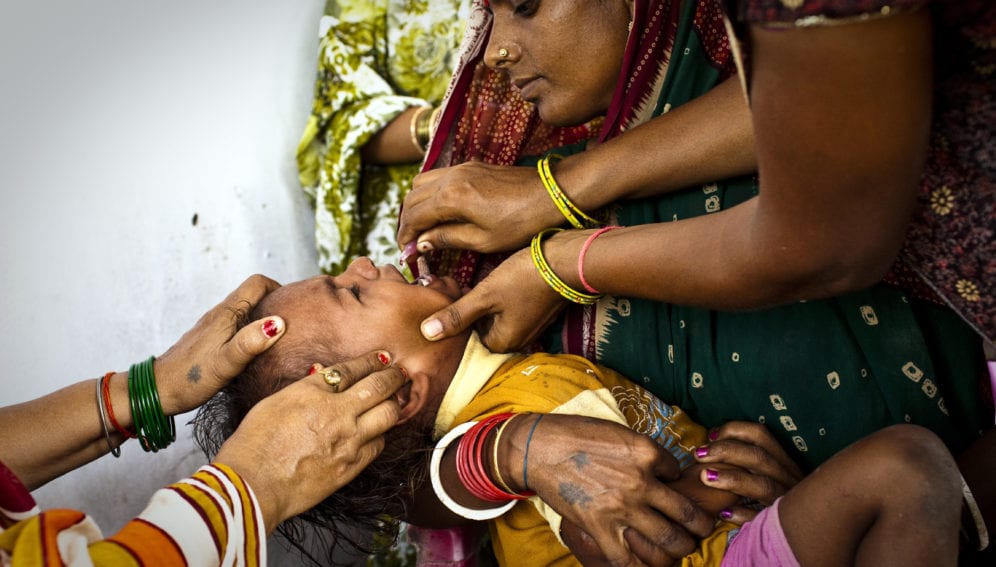
A small child is given oral polio vaccine
[NEW DELHI] While India’s oral polio vaccine (OPV) drives have eliminated polio from the country, they have also resulted in over 490,000 cases of paralysis during 2000—2017, says a new study based on national surveillance statistics.
India, a country of 1.3 billion people, was declared polio-free by the World Health Organization (WHO)in May 2014 in what was considered a landmark in the global drive to eradicate polio. Currently, the wild polio virus, which attacks the nervous system leading to childhood paralytic disease, is confined to Afghanistan, Nigeria and Pakistan.
“In the absence of wild polio transmission, it was expected that cases of paralysis would reduce to an acceptable rate of around two per 100,000, but this has not materialised”
Jacob Puliyel, St. Stephen’s Hospital
The oral vaccine uses live but weakened poliovirus strains to produce antibodies that protect childrenfrom being infected with ‘wild’ or naturally-occurring polio viruses. Mass oral vaccination drives are carried out thrice a year in India to prevent person-to-person transmission of the wild virus and maintain ‘herd immunity’.
Jacob Puliyel, head of paediatrics, St. Stephen’s Hospital, Delhi, and corresponding author of the study published August in the International Journal of Environmental Research and Public Health, says that “the frequency of pulse polio administration was found to be directly or indirectly related to the incidence of non-polio acute flaccid paralysis”.
Although India’s last case of polio was reported in 2011, a surveillance system continues to annually investigate some 50,000 cases of acute flaccid paralysis (AFP) — defined as a sudden onset of paralysis or weakness in any part of the body of a child under 15 years of age.
While no case of AFP has tested positive for polio since 2012, the rate of non-polio paralysis has continued to be unusually high, especially in the northern states of Bihar and Uttar Pradesh, which together have a population of 300 million people.
“In the absence of wild polio transmission, it was expected that cases of paralysis would reduce to an acceptable rate of around two per 100,000, but this has not materialised,” Puliyel tells SciDev.Net. The study found the paralysis rate to be as high as 30 per 100,000 in Bihar and Uttar Pradesh.
The study showed that the number of pulse polio rounds conducted in a state had a “high correlation” with the non-polio paralysis rate. “We found that the… rates in Bihar and Uttar Pradesh were higher in those years when the number of pulse polio rounds conducted were more frequent,” says Puliyel.
The study suggests that OPV were responsible for inducing paralysis and speculates that “repeated doses of the live virus vaccine delivered to the intestine may colonise the gut and alter the viral microbiome of the intestine”.
A microbiome is formed of an ecological community of friendly or pathogenic microorganisms that share body spaces. Of these, the gut microbiome is known to change quickly over the first two to three years of life and continues to change according to factors such as diet, environment and treatment with antibiotics or oral vaccines.
“While the mechanism involved is speculative, our findings support the hypothesis that the frequency of pulse polio administration is directly or indirectly related to the incidence of non-polio AFP,” the report says. “Now that India has been polio-free for over six years, we may be able to reduce non-polio AFP by further reducing pulse polio rounds.”
Puliyel says the increase in non-polio AFP was noticed only because of excellent surveillance and meticulous recording of data by government agencies. “The 491,000 additional cases of paralysis would not, otherwise, have been noticed.”
Puliyel and his team members hope that the results of the study will prompt reduction in OPV drives as measure against the relatively high incidence of paralysis in vaccinated children.
“There is a need to optimise the number and dosage of OPV rounds since there is the possibility of adverse effects arising from changes in the microbiome,” says Dinesh Kumar, paediatrician and researcher at the Holy Family Hospital, New Delhi. “It may be better, at this stage, to switch from OPV to inoculation as part of immunisation schedules,” Kumar tells SciDev.Net.
The WHO’s Polio Eradication and Endgame Strategic Plan 2013-2018 calls for a transition in vaccines requiring removal of all OPVs in the long-term to “eliminate the rare risks of vaccine-associated paralytic polio and vaccine-derived poliovirus”. This results from the attenuated or weakened vaccine strains turning virulent and capable of causing infectious poliomyelitis.
Madhavi Yennapu, principal scientist at the National Institute of Science, Technology and Development Studies, New Delhi, says the new study needs validation with serological data. “The real effects of OPV on the immune system of individuals as well as on herd immunity need to be studied as well as potentially adverse changes to the microbiome,” she says.
“Rationalising the number of national-level OPV rounds, based on scientific evidence, can have many benefits include huge savings on public health resources,” Yennapu said.
Source – https://www.scidev.net/asia-pacific/news/oral-polio-drops-linked-to-paralysis-in-india/
